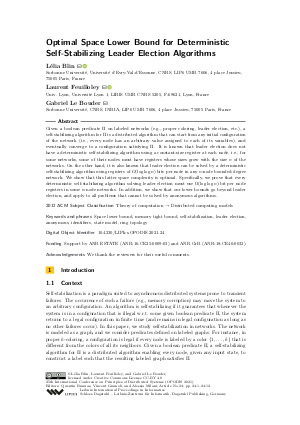@InProceedings{blin_et_al:LIPIcs.OPODIS.2021.24,
author = {Blin, L\'{e}lia and Feuilloley, Laurent and Le Bouder, Gabriel},
title = {{Optimal Space Lower Bound for Deterministic Self-Stabilizing Leader Election Algorithms}},
booktitle = {25th International Conference on Principles of Distributed Systems (OPODIS 2021)},
pages = {24:1--24:12},
series = {Leibniz International Proceedings in Informatics (LIPIcs)},
ISBN = {978-3-95977-219-8},
ISSN = {1868-8969},
year = {2022},
volume = {217},
editor = {Bramas, Quentin and Gramoli, Vincent and Milani, Alessia},
publisher = {Schloss Dagstuhl -- Leibniz-Zentrum f{\"u}r Informatik},
address = {Dagstuhl, Germany},
URL = {https://drops.dagstuhl.de/entities/document/10.4230/LIPIcs.OPODIS.2021.24},
URN = {urn:nbn:de:0030-drops-157997},
doi = {10.4230/LIPIcs.OPODIS.2021.24},
annote = {Keywords: Space lower bound, memory tight bound, self-stabilization, leader election, anonymous, identifiers, state model, ring topology}
}

 Creative Commons Attribution 4.0 International license
Creative Commons Attribution 4.0 International license
